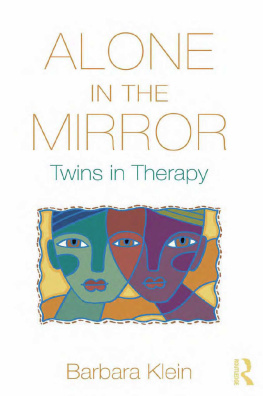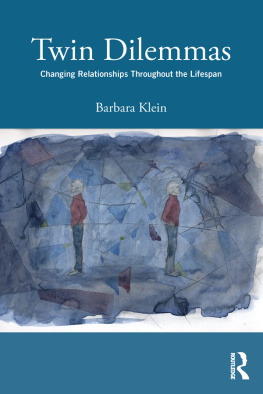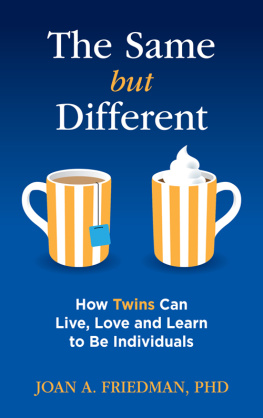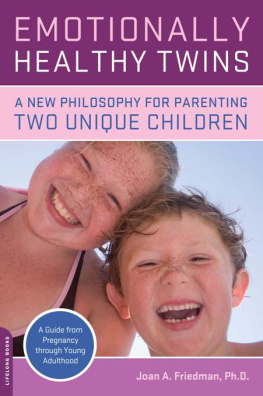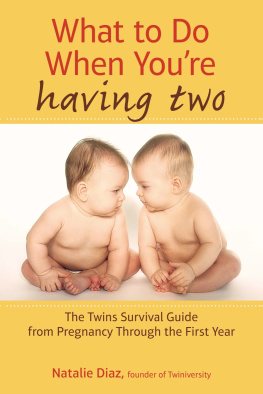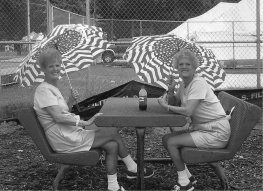
Alone in the Mirror
Books by Barbara Klein
Raising Gifted Kids: Everything You Need to Know to Help Your Exceptional Child Thrive
Not All Twins Are Alike: Psychological Profiles of Twinship
Forgotten Memories: A Journey Out of the Darkness of Sexual Abuse
Early Adolescence and the Search for Self: A Developmental Perspective (with Douglas Schave)
Issues in School Reform: A View From the Bottom-Up (with John D. McNeil)
Curriculum Design: A Handbook for Educators (with Kathleen Wulf)
Identity and Intimacy in Twins (with Janet Ciriello)
Alone in the Mirror
Twins in Therapy
Barbara Klein

Routledge
Taylor & Francis Group
605 Third Avenue
New York, NY 10017
Routledge
Taylor & Francis Group
27 Church Road
Hove, East Sussex BN3 2FA
2012 by Taylor & Francis Group, LLC
Routledge is an imprint of Taylor & Francis Group, an Informa business
Printed in the United States of America on acid-free paper
Version Date: 20111216
International Standard Book Number: 978-0-415-89340-4 (Hardback)
For permission to photocopy or use material electronically from this work, please access www.copyright.com (http://www.copyright.com/) or contact the Copyright Clearance Center, Inc. (CCC), 222 Rosewood Drive, Danvers, MA 01923, 978-750-8400. CCC is a not-for-profit organization that provides licenses and registration for a variety of users. For organizations that have been granted a photocopy license by the CCC, a separate system of payment has been arranged.
Trademark Notice: Product or corporate names may be trademarks or registered trademarks, and are used only for identification and explanation without intent to infringe.
Library of Congress Cataloging-in-Publication Data
Klein, Barbara, 1945
Alone in the mirror : twins in therapy / by Barbara Klein. -- 1st ed.
p. cm.
Includes bibliographical references and index.
ISBN 978-0-415-89340-4 (hardback : alk. paper)
DOI: 10.4324/9780203124178
1. Twin--Psychology. 2. Sibling attachment. 3. Therapist and patient. 4.
Attachment behavior. I. Title.
BF723.T9.K54 2012
2011042831
155.444--dc23
Visit the Taylor & Francis Web site at
http://www.taylorandfrancis.com
and the Routledge Web site at
http://www.routledgementalhealth.com
For Elizabeth, Jonathan, Kim, Paul, and Richard and my friends all over the country who shared their twin experiences with me
Though nothing can bring back the hour
Of splendor in the grass, of glory in the flower;
We will grieve not, rather find
Strength in what remains behind;
In the primal sympathy
Which having been must ever be
William Wordsworth
Contents
Foreword
Jacqueline M. Martinez, Ph.D.
We live in a world where the idea of twins often sparks fascination and an exoticism that leaves twins and non-twins alike without any real basis upon which to pursue a sustained reflection or study leading to deeper understanding. Why is it that we know so little about the real lives of twins? Why is it that we know so little about the particular challenges and joys of twinship as lived and experienced by twins themselves?
Ordinary science pursues knowledge directly related to twins; however, it is often motivated by a fascination and exoticism rooted in the recognition that identical twins constitute an ideal scientific laboratorytwo human beings with identical genes constitute the perfect scientific control group from which a whole host of human phenomena lying at the intersection of the physical and behavioral or social worlds may be studied. Studies of identical twins separated at birth, for example, often reveal fascinating and highly suggestive parallels in the lives of these twins. However scientifically useful these studies are, they tell us nothing about the reality of growing up as a twinin a twin relationshipand they sustain a sense of public fascination with twins as exotic.
For those who dedicate their professional lives to building therapeutic relationships that are ultimately accountable to human healing and the healthy psychic development of those they work with, an understanding of the realities of twinship is essential for success any time one is working with a twin raised in a twinship. In this context, academic and scientific questions aiming at some ultimate truth about the relationship between genetics and behavior are, at best, useless and, at worst, misleading if such truths stand as substitutes for the complexly intertwined dynamics that are always at work in twin relationships. And on this point, the only scientific knowledgethat is, knowledge arrived at through systematic, rigorous, and reflexive testingthat provides an adequate basis for understanding the lives of twins must be rooted in a phenomenological tradition. A phenomenological approach to the study of twins allows us to locate descriptions of the complex interrelationships through which twins negotiate the realities of their twin relationship and the challenges of living in a non-twin world.
Alone in the Mirror provides us with this kind of phenomenological systematic, rigorous, reflexively testedknowledge that comes only from years of sustained study of real people, dealing with the immediate pressures, struggles, and emotions of their lives, and within the context of the actual therapeutic relationships through which human healing and psychic health have been explicitly pursued. The most important point we must realize in recognizing the scientific foundation of this kind of work is that the human being, whose presence in the scientific endeavor can never be eliminated, is always, first and foremost, the essential conduit without which neither knowledge nor understanding is possible. In positivist science the problem of human presence is dealt with through systematic efforts to remove the variability of human perception and eliminate the means through which the particularities of the person doing the inquiry can seep into the actual studies conducted. This normal science method for dealing with the variability of human perception is untenable as a basis for knowledge that must be applied in the real living context of the therapeutic relationship. Unlike the normal science scientist, the therapist does not have the luxury of systematically removing the particularity of her or his perceptive capacity. Indeed, the therapists perceptive capacity is a primary and recurring touchstone of therapeutic work. Experience matters, and nothing can replace the learning by doing that is the process of all psychotherapeutic training. Of course, experience in and of itself does not necessarily teach us anything. Ones upbringing, professional training, and personal motivation all play crucial roles in how experience becomes knowledge that has the potential to provide genuine insight to a commonly shared social reality.
Alone in the Mirror exemplifies the kind of scientific endeavor informed by phenomenology that I am describing here. And this means that the particularity of its authors life and experience is essentially and directly relevant to what it achieves as a scientific endeavor. I dont believe it is common for therapists who write about doing therapy to feature aspects of their own lives as patients and persons dealing with the very life circumstances they are discussing. Yet, Dr. Kleins discussion of her own twinship, its internal dynamics, its dynamic within the family, and the evolution of her relationship with her twin throughout their lives, allows the reader to see the source of Dr. Kliens own seeing through which the knowledge presented here has been gained. As Dr. Klein walks us through the many ways that twins early attachment with each other is an essential part of their psychological development, and contributes to struggles with satisfaction in relationships, depression, anxiety, eating disorders, etc., she reveals for us the many unique challenges that twins present in psychotherapy. Because these challenges are not wholly different from the challenges presented by singleton patients, it is easy for them to be overlooked or misinterpreted. In the worst-case scenario, the therapists lack of awareness of how poignant these attachment and developmental issues are for twins leads to a perpetuation of the very dynamic the twin-patient is attempting to heal from and move beyond. The many real life stories of twins presented in this book provide enormous insight into the issues that therapists and laypersons alike must deal with in their relationships with a twin.
Next page
